


31 Hardware
This reference section deals with the T.O.V.A. hardware, what it does, and how to diagnose hardware problems.
-
T.O.V.A. USB device
- - See section 31.1.
- T.O.V.A. Microswitch
- - See section 31.2.
- Check T.O.V.A. Hardware window
- - See section 31.3.
- Display Calibration
- - See section 31.4.
- General audio
- - See section 31.5.
- PTE Audio
- - See section 31.6.
- EAV Audio
- - See section 31.7.
31.1 The T.O.V.A. USB device
The T.O.V.A. USB device is a miniature computer that is essential for administering the T.O.V.A. test:
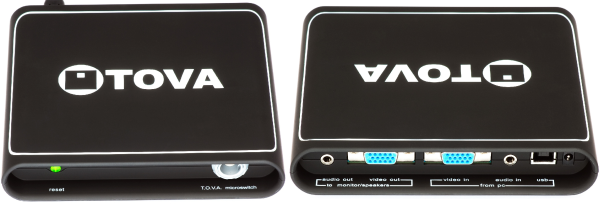
Front and back of the T.O.V.A. USB device
-
It measures the response time of your display, calibrating it for the visual T.O.V.A. test.
- During testing, it registers microswitch button presses with ±1 ms accuracy.
- It stores responses—your test data—until a test credit is spent to save the session to your database.
- It generates the External A/V test for the external monitor plugged into the device’s VGA ‘video out’ port and the external speakers plugged into ‘audio out’.
It’s also important to know what the T.O.V.A. USB device doesn’t do:
-
It doesn’t store your T.O.V.A. test data after it’s saved to your T.O.V.A. database.
- It doesn’t hold data from more than one T.O.V.A. test.
- It doesn’t boot the Precision Test Environment (PTE). The PTE boots from your computer or your T.O.V.A. boot media (flash drive or CD).
- It doesn’t adminster tests without test credits.
31.1.1 That Little Light
The light on the front of the T.O.V.A. USB device indicates to you and to us what the T.O.V.A. USB device is doing.
It can also be a distraction to your subjects, which is why we recommend that you keep it out of sight during testing.
The microswitch has a nice long cable for just this reason, and the reset light is recessed somewhat to make obscuring it that much easier.
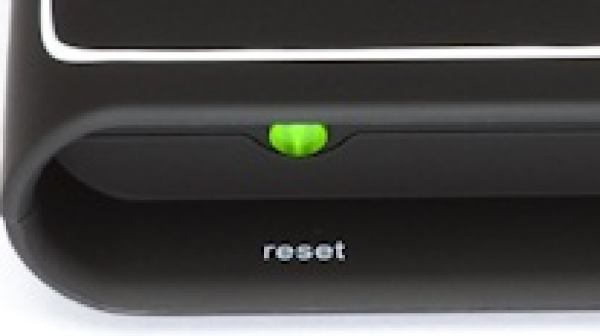
Reset light/button
Here are the colors you might expect to see using the T.O.V.A. :
|
Color | Status | Description |
|
Yellow | Powered | Device is finding power, but is not recognized by your OS.* |
|
Green | Ready | Device is attached and recognized by your OS. |
|
Blue | Testing | Device is running the T.O.V.A. test. If the device is disconnected or loses power while the light is blue, your test data will be lost. |
|
Red | Error | An error prevents testing (e.g., microswitch unplugged). The red light may blink to indicate a specific error. |
|
White | Switch down | The microswitch is being pressed (It doesn’t turn white during testing, to avoid distraction). |
|
|
* Note: A yellow light may indicate you haven’t installed the T.O.V.A. USB device drivers. You should install the T.O.V.A. software before you setup the hardware. See section 11.12 for information on installing the T.O.V.A. .
31.1.2 T.O.V.A. 8 hardware
To use the T.O.V.A. 9 software, you will need T.O.V.A. 9 hardware.
You cannot administer the T.O.V.A. 9 test with T.O.V.A. 7 or T.O.V.A. 8 hardware.
Please contact T.O.V.A. Customer Service (section 29) to purchase a T.O.V.A. 9 kit.
31.1.3 Device not found
If the T.O.V.A. does not recognize that your T.O.V.A. USB device is attached, try the following:
-
Before you attach the hardware, make sure you install the T.O.V.A. software.
- Make sure that the USB cable is firmly attached to the T.O.V.A. USB device and your computer’s USB port.
- Exit the T.O.V.A. .
- Disconnect and reconnect the device. When you reconnect, Windows may indicate this with a ‘T.O.V.A. USB Device’ balloon and/or a sound effect.
- If your OS recognizes the device, the light should turn green. Run the T.O.V.A. and the device should be recognized.
Other tips:
-
Make sure that you are plugging the device into your computer and not to a separate USB hub.
- Try unplugging other USB devices, especially any other testing hardware.
- If a USB port on the front of your computer doesn’t work, try one on the back, or vice versa.
- If your OS still won’t recognize the device being attached and the light remains yellow, disconnect your device and reinstall the T.O.V.A. software.
You can download the latest software by entering your T.O.V.A. serial number (found on the bottom of your T.O.V.A. USB device ) at https://www.tovatest.com/downloads.
31.1.4 Other device errors
Sometimes there can be communication problems with the T.O.V.A. USB device . There are two common causes of this:
-
Sleep mode
- - If your system goes to sleep while running the T.O.V.A. , it can lose its connection to the device, interrupt the test, and even lose your T.O.V.A. test data. To clear up the problem, exit and restart the T.O.V.A. . To avoid this problem in the future, we recommend that you disable sleep mode on your T.O.V.A. system. See section 37.1 for steps specific to your operating system.
- USB hub
- - If your T.O.V.A. USB device is plugged into a USB hub, you may get unpredicable communication problems. You should plug your T.O.V.A. USB device directly into a USB port on your system—USB hubs are not supported with the T.O.V.A. . See section 15 for more information.
If the above doesn’t resolve the problem, try the “Device not found" steps above (section 31.1.3). If it continues to happen, there may be a problem with your computer or your T.O.V.A. hardware–contact T.O.V.A. technical support for help (section 29).
31.1.5 Resetting your audio and video
If ever your screen will not show the correct picture or your speakers are making a sound they shouldn’t be, you can reset the T.O.V.A. USB device by pressing the button (that little light) on the front. That will return audio and video control to your system. If you’re still having audio or video problems then, it’s probably not the T.O.V.A. USB device causing them.
Note: You should also make sure that the USB cable is properly attached, as that power is needed to carry the audio and video signals.
31.2 The T.O.V.A. microswitch
Instead of mice or keyboards (both unpredictably inaccurate), the T.O.V.A. uses a standardized microswitch which performs reliably and consistently.
The T.O.V.A. microswitch has a built-in light sensor that we use to calibrate your display.
For more information on calibration, see section 20.5.1.

Connector
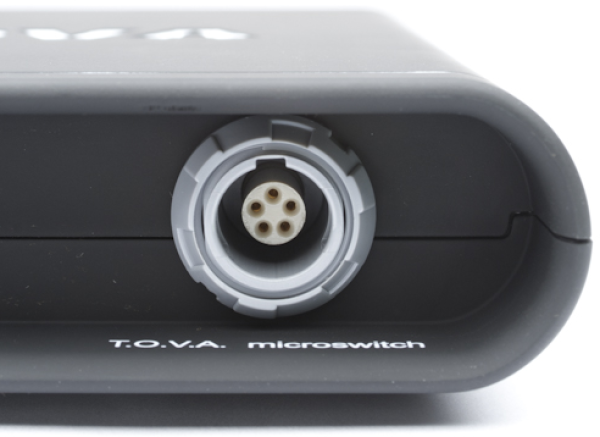
Microswitch Jack
To connect the new microswitch to the T.O.V.A. USB device , line up the arrows on the top of the connector with the top of the T.O.V.A. device and push it gently into the port. You do not need to twist or turn or squeeze in any way.
To disconnect the microswitch from the T.O.V.A. USB device , grasp the connector on either side and pull it gently but firmly out from the device. Again, you do not need to twist or turn or squeeze the connector in any way.
31.2.1 Why isn’t my microswitch working?
The T.O.V.A. microswitch gets the most use (and abuse) of any part of the T.O.V.A. kit, and a test taken with a faulty microswitch can’t be considered reliable.
-
Make sure your T.O.V.A. software is up to date.
Check the ‘Updates’ pane of the Status window or enter your T.O.V.A. serial number at http://www.tovatest.com/downloads to download the latest software for your T.O.V.A. hardware.
- If the T.O.V.A. software tells you the microswitch is malfunctioning, please contact T.O.V.A. tech support.
- If any part of the microswitch appears to be coming apart or shows exposed wires, contact T.O.V.A. customer service to replace it.
- If the light on the front of the T.O.V.A. USB device is red, make sure that the microswitch is plugged into the front of the T.O.V.A. USB device correctly.
Disconnect and reconnect the microswitch using the instructions above.
- Make sure the microswitch ‘feels’ right.
With a gentle press, it should make a sudden transition to the pressed state with a single click.
If it feels mushy, or very hard to press, or something is rattling in the case, the microswitch should be replaced and not used for further testing.
- Go to ‘Help’, ‘Check T.O.V.A. hardware’, ‘Check microswitch’ to test your microswitch button.
If there is or was a microswitch error, it may be indicated on this window as well.
See section 31.3 for more information.
- If, after trying the above, the microswitch fails intermittently, it should be replaced.
Do not continue testing with a faulty or failing microswitch.
If you need a new microswitch, contact T.O.V.A. customer service (section 29) immediately, so we can replace it as soon as possible. Note: We might ask you to send us the old one for quality control purposes.
31.3 Check T.O.V.A. Hardware
The Check Hardware window has information and tools for testing and fixing the T.O.V.A. USB device , the microswitch, and your system’s connections to them. Let’s review them briefly:
31.3.1 Hardware information
On the right side of the Check T.O.V.A. hardware window you are given all the information about your T.O.V.A. hardware.
-
Serial number
- - Your serial number (usually a five-digit number) uniquely identifies your T.O.V.A. USB device and may be used to identify you when you contact The TOVA Company for service or support.
- Report type
- - This identifies whether you have a Clinical or Screening device. The T.O.V.A. is not compatible with Screening devices.
Contact T.O.V.A. tech support (section 29) for more information.
- Credits remaining
- - You must have at least one T.O.V.A. test credit available to administer a T.O.V.A. test—you will use a test credit to save the results of that test. See Credits (section 22) for more information.
- Device version(s)
- - Gives the firmware version of your attached T.O.V.A. USB device and microswitch. When you update the T.O.V.A. (section 30), you will sometimes be prompted to update this firmware as well (section 30.2).
- Power source
- - Your T.O.V.A. USB device should always be able to run on power supplied by the attached USB cable.
- Session status
- - Usually, this will say ‘NONE’ to indicate that any session data has been saved or erased.
If it says something else, there may be session data still stored on the T.O.V.A. USB device .
Choose ‘Check for session’ (detailed below) to save any session data you wish to preserve, as soon as possible.
- Other error statuses
- - If there are problems with your T.O.V.A. USB device or microswitch, you may see other errors here as well. You should report hardware errors to T.O.V.A. technical support immediately to correct problems you may encounter.

Check T.O.V.A. hardware window
31.3.2 Hardware tools
-
Refresh
- - If you connect a new T.O.V.A. USB device , choose ‘Refresh’ to load its information
- Test your hardware setup
- - Runs the Hardware setup wizard, which verifies your T.O.V.A. hardware connections step by step (see section 16).
- Check EAV audio
- - Lets you play audio from your sound card and from the T.O.V.A. USB device , and adjust the EAV volume to balance the two.
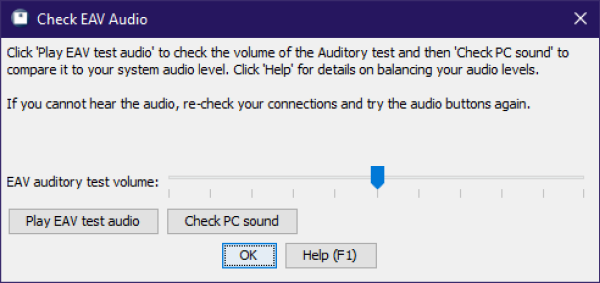
Check the audio volume for EAV testing
- Check EAV video
- - Presents images from the T.O.V.A. USB device to your external display to verify that the video has been hooked up correctly
- Check microswitch
- - This helps you verify that the microswitch is properly attached and recognizing button presses. See section 31.2.1 for more information.
- Check USB communication
- - This experimental feature tests communication with the T.O.V.A. USB device . Note: Any session data on your T.O.V.A. USB device will be overwritten–only use at the direction of technical support.
- Help
- - Opens the User’s Manual to this section
31.3.3 Advanced hardware tools
Below these are more advanced functions. Note: You should not use these without direction from T.O.V.A. technical support.
-
Device commands
- - Useful only at the direction of T.O.V.A. Technical support
- EAV calibration
- - Recalibrates your display for EAV testing
- View EAV calibration
- - Presents the latest results of display calibration for the EAV, with a brief explanation of errors
- View PTE calibration
- - Presents the latest results of display calibration for the PTE, with a brief explanation of errors
- View clipboard calibration
- - Useful only at the direction of T.O.V.A. Technical support
- Check for session
- - Manually checks if there is an unsaved test on the T.O.V.A. USB device and offers to save the data.
- Reject session
- - Allows you to erase unsaved test data from the device.
Note: Data is removed from the device when it is saved to the database.
If you do erase data from the device instead of saving it, it will be lost forever.
- Update firmware
- - Updating the firmware should happen automatically, if ever necessary, when you update the T.O.V.A. (see Updating the T.O.V.A. , section 30). This option is only useful at the direction of T.O.V.A. Technical support.
- Update microswitch
- - Updating the microswitch firmware should also happen automatically when you update the T.O.V.A. (see Updating the T.O.V.A. , section 30). This option is only useful at the direction of T.O.V.A. Technical support.
31.4 Troubleshooting Display Calibration
You must calibrate your display to administer the visual T.O.V.A. test.
Whether it’s a modern LCD display or a big, old CRT monitor, every display has some delay, however brief.
Calibration allows the T.O.V.A. to properly account for your display’s specific timing,
so that the results of the T.O.V.A. will be as precise and accurate as possible.
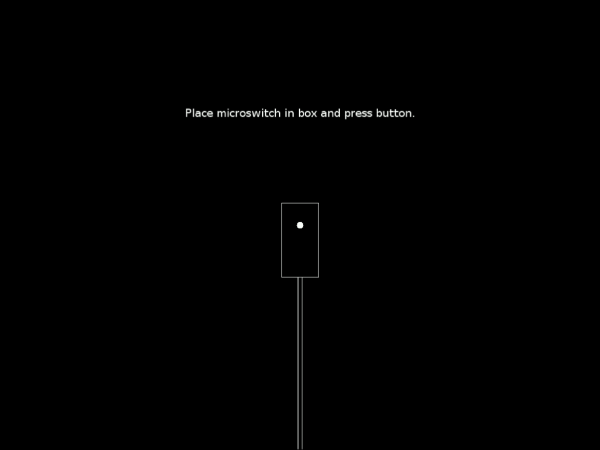
Hold the photodiode up to the rectangle on the screen
Most displays will calibrate successfully. However, others may encounter errors during calibration.
The first thing you should do if your calibration fails is try it again. Make sure that you’re holding the microswitch so that the bottom of the microswitch (where the photodiode window is) is directly touching the surface of your screen, but not pressing down hard. The button should be facing outward from the screen and the cord should be hanging down from the back of the microswitch, as indicated on the calibration diagram (Figure 63). Calibration may take a minute or so, but try to hold the microswitch still.
Secondly, some displays may take a few minutes to finish warming up. Restart the calibration and leave the message “Place microswitch in box and press button” on the screen for at least two minutes before starting a second time.
Thirdly, your display may be too dim, and you should increase the brightness and try calibration again. Once calibration is complete, you can lower the brightness again as appropriate.
If you continue to get the same error, the problem can be diagnosed here:
-
Calibration was interrupted.
- - Your calibration was interrupted before it could be completed. You should try calibration again and let it complete.
- The photodiode on the T.O.V.A. microswitch is not seeing the calibration flashes.
- - There are some common reasons for this:
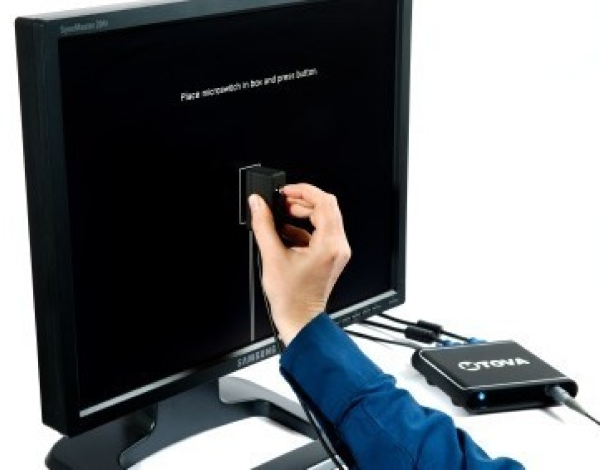
How to hold your microswitch for calibration
-
You may not be holding the T.O.V.A. microswitch correctly. Make sure the photodiode window on the back of the microswitch is inside the box on the calibration screen. Make sure the back of the microswitch is actually pressed up against the front of the display. See Figure 64 or go to http://videos.tovatest.com for an instructional video.
- Your display may still be warming up. Restart the calibration and leave your display showing the “Place microswitch in box and press button" screen for at least two minutes before starting the calibration routine.
- Your display may be too dim. Try increasing the brightness on your display. Note that if the screen appears too bright after this change, you can reduce the brightness again after calibrating.
- There may be too much light on the display. Direct sunlight shining on your display can sometimes flood the display. Make sure the front of your display does not have direct sunlight on it.
- Calibration results had too much drift over time
- - Some displays introduce random delays in the display of the visual stimuli and thus are not accurate enough for use with the T.O.V.A. test.
- The calibration results were too variable
- - This indicates that our T.O.V.A. hardware could not perceive a consistent video timing pattern.
- The calibration routine cannot determine if this display can be used
- - Timing was not quite consistent enough to calibrate. This usually indicates your display just needs to warm up a bit more.
Once you get a successful calibration, you should be good to administer the test, and you won’t need to recalibrate every time. If you replace your system’s monitor or video card, however, you should always recalibrate the T.O.V.A. to the new display hardware.
If you continue to receive errors, your display may not be capable of accurately administering the T.O.V.A. test.
The T.O.V.A. will not administer the visual T.O.V.A. test on a display unless it can be successfully calibrated.
Please contact T.O.V.A. technical support (see section 29), so we can get more information about your monitor and recommend other models that will work better.
31.5 General Audio Troubleshooting
Audio is an important part of the T.O.V.A. .
The T.O.V.A. test instructions are spoken by your computer.
The auditory test complements the visual test by measuring attention differently.
As a result, we want the T.O.V.A. to work with your system’s audio hardware.
Are your test instructions too loud and your auditory test too quiet, or vice versa?
If you’re having sound problems with the T.O.V.A. , we can help you fix that.
The PTE and EAV tests each have their own volume settings. The sections to follow can help you address volume problems in each testing environment, but first a couple of general audio tips.
31.5.1 Your Speakers
The easiest way to control volume is by raising or lowering the volume on your external speakers. However, if you have no external speakers–a laptop with a basic PTE hardware setup (section 15.1), for instance—you can skip to the next section.
If you can’t hear the auditory test or the test instructions, check your speakers first: Are they plugged in, turned on, and turned all the way up?
31.5.2 Instructions audio
The test instructions are accompanied by audio by default. Press the space bar to pause or restart the instruction audio and the ‘S’ key to turn the audio on (or off) while the instructions are playing. Note: With the instruction audio off, the instructions must be advanced manually, using the right arrow key.
31.6 Troubleshooting PTE Audio
For audio problems in the PTE, use the PTE volume controls. From the main PTE menu, press ↑ to raise the volume one step and ↓ to lower it. Each time a brief audio clip will be played, and a number will be displayed. The volume level you choose will be stored when you return to your OS and preserved for your next PTE session.
Note: These volume controls are only available from the main PTE screen and not during the T.O.V.A. test or the Test Instructions.
A Note on the Auditory Test: If the target (higher) tone is significantly louder than the nontarget (lower) tone, the problem is the bass response of your speakers. This can often be an issue with laptops, and you will need to use different speakers to resolve this. Contact T.O.V.A. customer service for recommendations.
31.6.1 PTE Audio Device menu
If your sound works fine in your OS but does not work in the PTE, the PTE may not be selecting the correct audio hardware. You may see an audio error or the speaker button at the bottom of the main PTE menu will be disabled.
First, click the wrench button (or press ‘Alt’ + ‘A’). The next steps vary between the modern and legacy PTE:
In the modern PTE (1.1):
-
Choose the ‘Audio’ tab.
- From the ‘Audio device’ drop-down, select another device.
- Click ‘Play sound’ to play a brief audio clip through the speakers.
- Click ‘Close’ to return to the main PTE menu.
In the legacy PTE (9.1):
-
Choose ‘[C]hange audio device’ to present a menu of all of the audio devices the PTE can detect.
- Select a device, even if there is only one listed, and an audio clip should play at the current volume to test out the device.
 ‘[C]hange audio device’
‘[C]hange audio device’ brings up the audio device selection menu
If the audio played correctly, great! Resume your PTE test session or click ‘Done’ to return to your OS. Your device selection will be preserved.
If you get an error after choosing the audio device, go back to ‘Change audio device’ again and select a different audio device, if any.
If you try all the devices here and no audio plays, your audio hardware may be incompatible with the PTE.
If this is your situation, please contact T.O.V.A. tech support. We are doing our best to make the T.O.V.A. PTE work for every sound card.
31.6.2 Adjust Audio Levels
Note: Please use this screen carefully, preferably on the advice of T.O.V.A. technical support. The main PTE volume and mixer defaults will work best for most systems, so if it ain’t broke, don’t fix it.
While the T.O.V.A. PTE has gotten increasingly proficient at recognizing hardware and adjusting settings to the right default levels, some computers may still need additional tweaks.
If your audio is too quiet, too loud, or distorted somehow, and the main PTE volume can’t correct the problem, the latest PTE version has an audio mixer that might help you.
Click the wrench button at the bottom of the main PTE menu (or press ‘Alt’ + ‘A’).
Click the ‘Audio’ tab (or choose ‘[A]djust audio levels’ in the legacy PTE).
Here you will be able to see and adjust all the channels for your computer’s audio device.
The bar indicates the volume level, and the box next to it whether the channel is turned on or off.
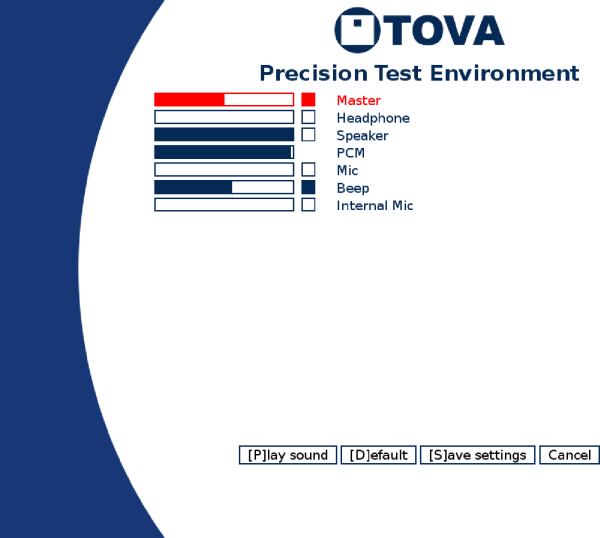
Only the Master and Beep channels are turned on here
Please note that this screen is not about selecting a specific channel to be used by the T.O.V.A. , but rather the audio levels contributing to the sound in the T.O.V.A. . Some may be best turned off, and some may have no effect whatsoever. We are happy to help you find the settings that will work best for your system.
-
Every sound device will have its own set of channels. Yours may have more, fewer, or different channels than you see in Figure 66.
- You can adjust channels by clicking the volume bar where you want the level to be, or clicking the square to toggle the channel on or off.
- You can also adjust channels with your keyboard. The channel selected to adjust will be red. Click the up/down arrow keys to select a different channel to adjust, left/right arrow keys to raise or lower the volume for that channel, and the space bar to toggle the channel on or off completely.
- Click ‘[P]lay sound’ to hear the sound at your adjusted levels.
- Click ‘[D]efault’ to revert to our default audio levels for your system.
- Once you’re finished, click ‘[S]ave’ to preserve your changes, and when you boot back to your OS, your changes will be remembered for future PTE sessions.
- Click ‘Cancel’ to abandon any changes you just made.
- If you call tech support, we will help you find the right adjustments for your system and environment.
31.7 Troubleshooting EAV Audio
Let’s talk about how to resolve audio problems with the External A/V (EAV) test.
31.7.1 EAV hardware setup
Make sure you have your T.O.V.A. hardware set up correctly for EAV testing.
31.7.2 EAV volume controls
T.O.V.A. test instruction audio comes from your computer.
However, during an EAV auditory test, the T.O.V.A. USB device will play the tones.
So you have multiple audio sources and multiple volume controls: your OS’s volume (which may have more than one control), the T.O.V.A. USB device ’s volume, and your speakers’ volume.
Here are steps you can follow that will solve most EAV audio problems:
-
Run the T.O.V.A. .
- Go to ‘Help’, ‘Check T.O.V.A. hardware’, and then ‘Check EAV Audio’.
- Click ‘Play EAV test audio’ and note the volume of the audio that plays.
- Click ‘Check PC sound’ and note the volume of the audio that plays.
- If both are too loud or too quiet, adjust your speakers and go back to Step 3.
- If you cannot hear the EAV audio, try swapping the audio cable plugs: you may have ‘audio out’ and ‘audio in’ reversed. Then go back to Step 3.
- If the computer sound is too loud or too quiet, adjust the volume for your OS.
You may have buttons on your keyboard for this purpose, or a small icon you click on to bring up your volume control.
Adjust the volume there and go back to Step 3.
- If the EAV audio is too loud or too quiet, choose a different value for the “EAV auditory test volume" and click ‘Play EAV test audio’ to test the new volume.
- If you can hear the high tone of the auditory test well but not the low tone, the problem is probably the bass response of your speakers. You may need to use different speakers. Contact T.O.V.A. customer service for recommendations.
31.7.3 EAV audio errors
If you see an audio error when launching an External A/V (EAV) session, please try these steps:
-
Check your T.O.V.A. hardware setup (section 15.2).
The standard EAV hardware setup on a desktop involves an audio cable running from your computer’s speaker or headphone jack to the ‘audio in’ jack on the back of the T.O.V.A. USB device .
If that cable is missing, it may trigger an error.
- Test your computer’s audio outside the T.O.V.A. .
Try playing music, video, or a game on your computer.
If sound doesn’t work in other applications, it won’t work in the T.O.V.A. either.
Contact your computer’s support for general audio problems.
- If audio works in other applications on the computer, and your T.O.V.A. hardware is installed correctly, please contact T.O.V.A. tech support (section 29).
- An audio error will not affect an EAV test, only the test instructions. Read the instructions aloud to the subject, and use the left and right arrow keys to change slides.
31.7.4 Speaker noise
We have noticed that sometimes you can hear noise with the EAV setup that you don’t hear if the speakers are plugged directly into your computer.
We’ve found this is specifically the case with some laptops—that’s because the laptop is actually producing the noise.
While the T.O.V.A. USB device may not be producing this noise, it might be amplifying it.
Fortunately, the static or whine should go away during Auditory testing, when the computer’s sound is cut off.
If you find that it does not, try different speakers or contact T.O.V.A. tech support.



 Front and back of the T.O.V.A. USB device
Front and back of the T.O.V.A. USB device